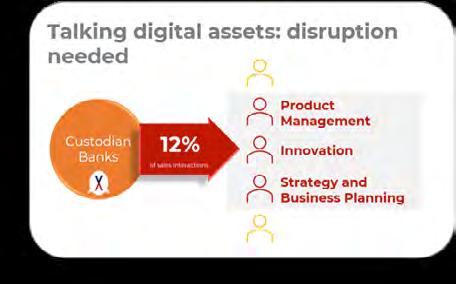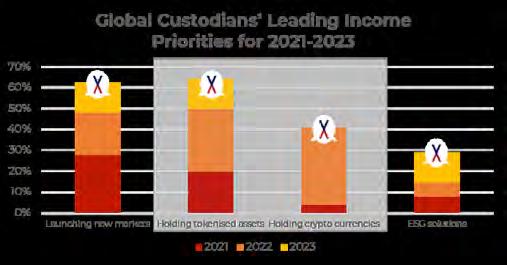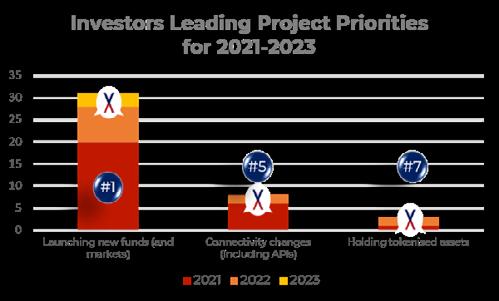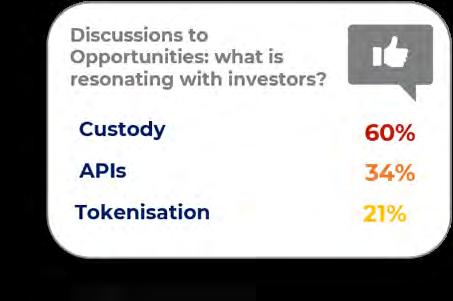
3 minute read
Commercialising Digital Assets – More Disruption Needed
from TNF Issue 7
Digitisation has dominated industry headlines and discussions since 2018. Whilst investors have faced ever-growing pressures to ‘right-size’ their organisations and processes, their providers have put digitisation and tokenisation, specifically, at the forefront of their investment and development plans.
But how and where are these providers going to see returns on their blockchain investments? Are they ready to start commercialising digitisation today?
Leveraging sales performance data from our sales campaign platform (Agile Impact Metrics), the ValueExchange’s data in 2021 shows that selling DLT is not as simple as it seems.
1. Tokenisation is central to Global Custodians’ futures
There is no doubt that digitisation is at the centre of the customer conversation today for custodians across the globe. Up to 64% of custodians have tokenisation-related projects ongoing or planned over the next 3 years – putting digital assets at the forefront of their nearterm revenue ambitions. This number swells further when crypto-assets are included in the revenue priorities. With over 90% of custodian banks now allocating resources to DLT and blockchain, the industry is taking a big bet on digital disruption.

After years of intense revenue pressures, continuing workflow adjustments and ongoing regulatory change, the majority of investors are today focused on more immediately realisable objectives. Investment returns now lead their priorities (ahead of cost control and internal priorities) – as investors shift from an extended period of risk management into a new phase of growth.

3. Reshaping sales and customer networks
The challenge is not only one of shaping the narrative –it is also about who this narrative is with.
Our ‘DLT in the Real World’ research campaign highlighted (run with ISSA and Accenture) that the 3 business units leading the blockchain charge in a typical firm are Innovation teams, Product Management and Strategy / Business Planning. As we continue to experiment with and develop digital asset platforms, our exposures and our expertise are centralised in these non-operational departments – away from the teams responsible for functional, daily operations.
The ValueExchange’s recent outsourced sales campaigns have shown that only 12% of custodian banks’ sales engagements are with these functions today – meaning that custodians face a serious connectivity challenge. If their daily client counterparts are not responsible for digital assets then 88% of their client calls are with the wrong people.
more counterparties to close the deal – and is hence faced with a unusually high level of complexity in managing their opportunities and pipeline.
Amongst that expanded ecosystem, salespeople need to master a new profile: that of their customers’ customer. Over 56% of customers’ digitisation plans are now being shaped not around their own needs but around those of their own, upstream customers. Far from being able to rely on single relationships with their clients, tomorrow’s salespeople will have to rely on an entirely collaborative sales engagement – where the custodian’s offering is simply embedded into that of their direct customers.
Business case, connectivity and sales model: more disruption needed
And even in the infrastructure and post-trade space, investors are more inclined to invest their time in API- and connectivity-related projects than they are in tokenisation. Fund managers of all profiles need to see immediate returns from technologies that can deliver in the short term –and blockchain does not yet seem to be making the grade. Whilst an API can deliver significant efficiencies in weeks and months, the short to medium-term benefits of tokenisation and blockchain seem worryingly unclear to investors.

The majority of custodian banks who are ‘betting the house’ on their ability to commercialise digital assets therefore face a key dependency. If they are to monetise their digital asset platforms, they must first disrupt and transform their customer networks and take their story to the right customer stakeholders.
There is no shortage of commercial intent in the fast growing digital asset space – and global custodians seem singularly focused on monetising this new technology as fast as possible. But if their commercial ambitions around digitisation are to be realised, sales engagements will need to transform as much as operational workflows.
This will require a new sales narrative that defines more clearly the immediate business impact of digital assets for investors; and it will require a profoundly different sales engagement that involves new stakeholders, shaped around the needs of the customer’s customer.
Would you like to know more about how your own firm is taking digital assets to your customers? If you would like to partner with the ValueExchange to run your own Agile Impact Metric campaign then please contact us at info@thevalueexchange.co

2. Investors don’t see the value yet
But it is not clear that their investor customers view tokenisation with the same level of intensity as their service providers.
This shorter-term focus shows through in daily sales interactions with investors. Whilst 60% of custody-related sales conversations lead to an opportunity for leading providers, these banks struggle to convert more than one in every five client discussions into a continuing tokenisation discussion.
4. Digital assets: a multi-dimensional, collaborative sale
But the transformation can’t stop there. Unlike most (bilateral) securities services sales, the commercial success of digital assets relies heavily on engagement across a multi-lateral ecosystem. A successful salesperson in the digital asset space is reliant on exponentially







